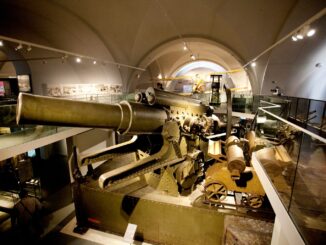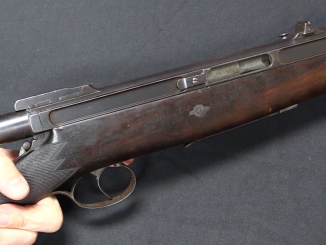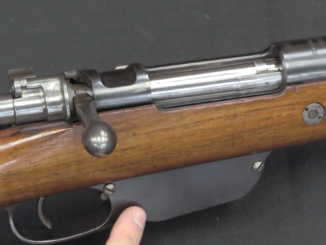In 1909, the Austro-Hungarian Empire announced a desire to find a new semiautomatic military rifle, and requested proposals from arms manufacturers. Six rifles were submitted to the resulting trials in 1911, including this model from Steyr chambered for the 7x57mm Mauser cartridge. It uses a two-lug rotating bolt and a short stroke annular gas piston system very similar to the German Gewehr 41 of three decades later. It also featured an unusual rotating dust cover, which was automatically opens and closed by the cycling bolt.
The trials resulted in no rifle being deemed suitable, and further development was interrupted by the First World War. In the after math of the testing, Steyr did release a civilian pattern version of the rifle in 6.5mm Mannlicher but did not garner significant sales. Total production is not known, but was very small.




These rifles are beautiful, complicated and expensive. It is no surprise that the Austrians decided to stay with their Mannlichers.
The notch on the rear sight of the military model seems absolutely tiny. Did people have better eyesight back then? Maybe all these years of looking at screens really have ruined our eyes?
What we think of as “precision rifle fire” was a concept not generally considered by Continental armies back then. And the word “ergonomics” wasn’t in most dictionaries.
Long-range (beyond 150-200 meters) rifle fire was still considered to be a volley-fire affair in most drill manuals. The idea being to blanket an area with bullets to stop unruly mobs of charging natives.
The machine gun largely took over this duty by the turn of the last century, but the principle was still believed in by the commanders, right along with bayonet charges over long, open ranges. Something else machine guns could deal with very effectively, a point not recognized until about 1915- after the First Battle of the Marne. It took the Somme in 1916 and 3rd Ypres (Passchendale)in 1917 for some senior officers to actually “get it”. (Although I suspect that Foch never really did ever figure it out.)
So rifle sights were designed for shooting individually at short range and in unison, on command, beyond that. For that kind of shooting, the narrow, in fact probably too small to see, notches and front sights of rifles like this was theoretically all that was required.
No, the lessons of the two Boer Wars and World War One were not learned, or applied, until well after World War Two.
cheers
eon
“(…)unruly mobs of charging natives.(…)”
Wait, what overseas territories complete with mobs of charging natives did have Austria-Hungary in 1911?
Bohemia.
😉
Name one military action involving a Bohemian version of Rorke’s Drift. For educated engineers and amateur historians you lot have some wild fantasies
Eon, you are so wrong. “Ergonomics” wasn’t in any dictionaries, it wasn’t coined until the 1950s.
And more importantly, long range marksmanship (up to 500 or 600 yards/meters)was absolutely stressed in training. Beyond that, an individual soldier’s chance of hitting a target smaller than a house was so slight that only collective fire made sense.
Let’s put it this way: the higher-ups tried to force any new tech to fit the old doctrine, even if it hurt the rifleman and the quartermaster in the process.
“One rifle shot should be enough to kill one foe. Anything amounting to more than 20 foes should be dealt a rifle volley or cannon-fire. And anything that survives a single salvo of cannon fire will be given a day’s worth of artillery barrage or until I hear the enemy beg for mercy.”
In the period leading up to WW1, the Drill Manuals used by most armies were basically the same as those of the 1870s. Those manuals had been written around the then-new first generation single-shot metallic cartridge breechloaders, firing round-nosed lead bullets in the 11mm to 14.5mm bore range at velocities in the 1,200 to 1,500 F/S muzzle velocity range.
Those low-velocity rounds had high trajectories at any range beyond about 200 yards. The fire tables for the .577 Snider-Enfield lists 250 yards as the maximum sighted “Throughout” range; that means sighted at 250, the bullet’s trajectory would not rise high enough to go over the head of a standing man at any point along its path, assuming you aimed for his upper chest like you were supposed to.
At a sighted range of 500 yards, the bullet would pass over the head of a standing enemy soldier at 250. Sighted at 800, it would pass over the head of a man on horseback at 400.
As the infantry rifle evolved through first smaller calibers, but still with round-nosed bullets and compressed black-powder propellants in the 1880s, and then to higher velocities with spire-pointed bullets and smokeless powder in the early 1900s, the manuals never really changed. It was still aimed fire to 200 yards, volley fire to 600, and beyond that…call for artillery.
The British Territorials were the main exponents of long-range, aimed fire, but that was not the view of Europe’s armies. The difference was that Europe’s armies hadn’t gone round and round with the Boers twice.
Marksmanship training wasn’t really a priority with Continental armies, other than Switzerland. “Training” was mainly about dressing ranks and marching in proper formations on parade. As for actual shooting, it cost money and required more frequent cleaning and maintenance of uniforms an weapons and we’re sorry, it just isn’t in the budget; The Emperor says the Navy need those new dreadnoughts, after all, so we have to cut somewhere.
So no, long-range aimed rifle fire other than suppressive volley fire wasn’t in the European armies’ playbook until well after the First World War. And by that time, it was viewed mainly as what you did when the heavy machine guns and the howitzers were otherwise occupied.
It’s interesting to see Western armies today undergoing a similar process in trying to recalculate their marksmanship training and expectations, much as they did a century ago. In this case, the main reason is the inherent limitations of the 5.56 x 45mm cartridge.
And just as it was a century ago, they’re having problems with un-learning the incorrect lessons, and figuring out what questions they should have been asking the whole time.
cheers
eon
JohnK: Did people have better eyesight back then?
They probably did. Less time in childhood doing close-work and reading, so they preserved their distance vision and accommodation for years, maybe decades longer. Myopia is now pandemic, and we won’t even discuss the rising retinal sep risk.
re: Maybe all these years of looking at screens really have ruined our eyes?
In addition to being close-work most of the day, with a complete absence of preemptive +diopter reading glasses for kids, it’s a major circadian hazard (blue light at night, not to mention checking FB at 3AM, even with blu-blockers).
Techno:
Interesting comments. I tend to agree with you.
When you look at the sights on 19th century weapons they are almost too tiny to see through. There must be a reason for that. People back then were not stupid, and it would have been very easy to have made bigger sight notches. I can only conclude they were not needed, and that the tiny sight notches used then sufficed, because the average person could use them.
The fact that we can’t use them today is our problem, not theirs!
A very interesting and curious gun (I also would like to see any performance information). Inviting comparisons also with the French Meunier and Bang (+ its various clones and variations) rifles. Concurring that it considerably over complex etc. for a military rifle (particularly for that time)and can understand why they not too keen to adopt or manufacture it.
“(…)Concurring that it considerably over complex etc. for a military rifle (particularly for that time)and can understand why they not too keen to adopt or manufacture it.(…)”
That is possible, but on the other hand they produced (ridiculously over-complex in manufacture by today standards) Repetierpistole M.7
https://modernfirearms.net/en/handguns/handguns-en/austria-semi-automatic-pistols/roth-steyr-krnka-m7-m1907-eng/
One of its developer was Karel Krnka (NOT to be confused with designer of M1867 Russian Krnka also bearing that name), who IIRC one of previous discussions at this site, was against usage of gas-operation in fire-arms. I do not know if he had any formal ways of influencing final outcome, but he might some indirect one, if he was deemed authority* by people responsible for fate of this project.
Finally, there is question of ammunition, as this weapon would required switch from 8 mm Mannlicher cartridge to other one as default infantry rifle cartridge which means it would be of greater order of magnitude than in case of handguns.
Finally at that time Austria-Hungary seems to be unsure, about which rifle cartridge should become theirs next – considering that in 1914-15 they tested at least 4 different cartridges, according to http://hungariae.com/Mann14.htm
Four known rifle variants were entered eventually for the Austrian trials:
1. A Mauser M1914 designated Gew.98 Mauser in an M.95 stock, in 8x56r caliber
2. A Mauser M1914 designated copy of the M1912 Mexican Mauser, in 7×57 caliber
3. A Mannlicher 14.M designated straight pull Mannlicher, in 7×57 caliber, for details see below
4. A Mauser M1915 designated Mauser Mannlicher-Schönauer hybrid rifle, in 7.92x57mm caliber
Note that theirs default 8 mm Mannlicher rifle cartridge still used round-nosed bullet and therefore behaved more differently from 7,9×57 mm Mauser (with Spitzer bullet) than their difference in caliber (7,9 mm vs 8 mm) might suggest.
* Karel Krnka published possibly first classification of automatic fire-arms – Kaisertreu Classification
A pistol in the Austro-Hungarian k.u.k. was an expensive rank insignia… A piece of high-priced, aristocratic frippery. A universal service rifle, or even an elite chausser/jäger rifle is another thing entirely. Most Austro-Hungarian NCOs probably toted the M1898 8-shot 8mm Rast-Gasser revolver. Certainly the big black-powder cartridge Gasser revolvers were popular with storm troops. The k.u.k. in WWI contemplated arming the storm troops with pistols only, but pistol manufacture would not have been able to keep up with the demand. They also had a welter of four (five even?) designs to contend with. Their uniforms were often multi-hued, particularly as the First World War dragged on.
The M1912 Mausers intended for Chile and Mexico in 7mm were manufactured at Steyr-OEWG, and were promptly used alongside Steyr-manufactured rifles of all kinds, including the Steyr-Mannlicher and Schönauer intended for the Greeks.
The troops so armed arguably had the best rifles in the k.u.k. army!
As for this odd Steyr self-loader, do we have here something like a “missing link” between the German Gew.41 and the Garand rifle? That op-rod with the dual opposed front locking lugs and the spring within the op-rod rather than behind the bolt… The cartridge clip restraining the bolt from flying forward as the magazine is loaded… The ultimate use by the RSC-17 and later Garand of a Mannlicher-style en-bloc clip? Hmmm.
Very interesting! What a beautiful rifle.
Must admit that I’m a bit surprised to see a semiautomatic being considered this early. Yes, they were other early examples, but apparently it was more common than what I thought!
Would have loved to see Ian shoot it btw! Wonder what it would have been like to shoot with the 7mm round.
The checkering on the trials rifle was intended to put the commissioners in a good mood.
It would be interesting to see an M1 or SKS with the same cosmetic treatment.
It seems more similar to the G 41 from Mauser, who was even more complicated: the two bolts are identical. Same Bang gas system.
Although the original Søren Bang system had it that the gas cap was pulled forward by expanding gases at the muzzle, and that motion operated the action, rather than being pushed backward by the muzzle blast against an annular piston…
It was complicated as heck also to get around particular patents of the time or just because someone wanted an “easy” conversion to sell to the military establishments of the era, if I’m not mistaken. I hope I’m wrong on both counts.
Note that in Bang action opening starts as late as possible, thus it should be (at least in theory) possible gentle in cartridge handling. This should lessen required integrity of cartridge (force needed to push out of case mouth) and thus allowing Bang to use cartridge, which might not work properly in more hefty systems.
c.f. Farquhar-Hill
https://modernfirearms.net/en/military-rifles/self-loading-rifles/great-britain-self-loading-rifles/farquhar-hill-eng/
which also was more complicated that simplest gas-operated system, yet offered more smooth distribution of action opening force.
Gentle extraction is a good thing if you’re looking to keep torn casings from becoming a problem in the middle of a fight. For this, proper crafting and testing is needed to balance handling, maintenance costs, and overall performance. Does the usual soldier need a more substantial cleaning kit for a more complicated action? Probably so…
That 06h had a rotating dust cover, if I remember; anyway theres probably a good chance Nazi German gun designers looked at this.
Interesting piece.